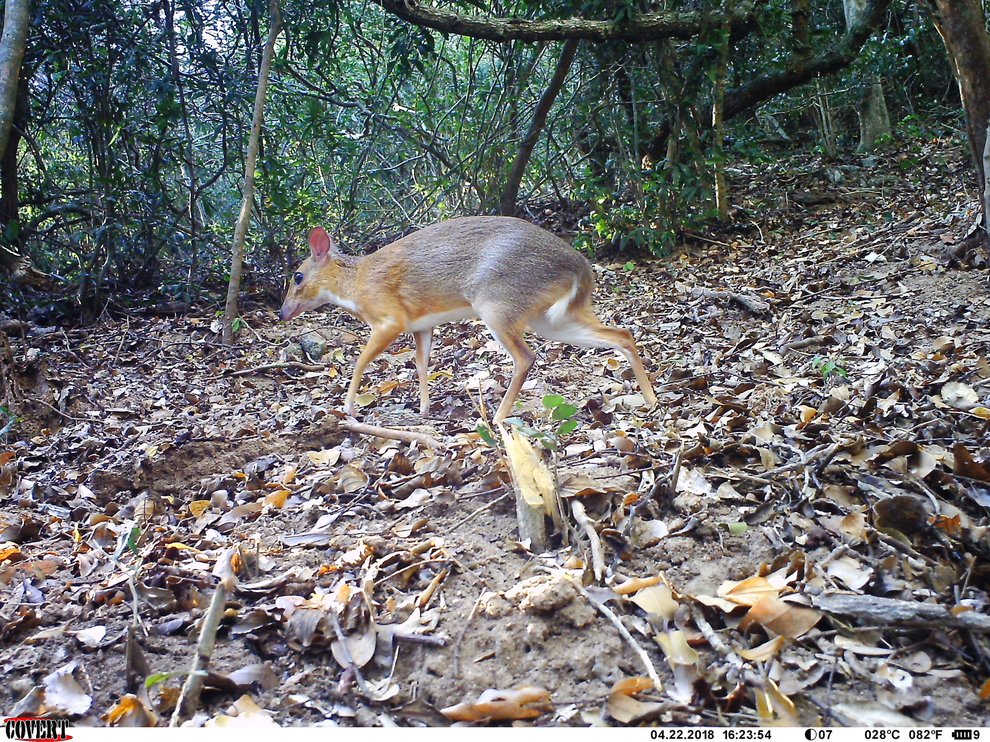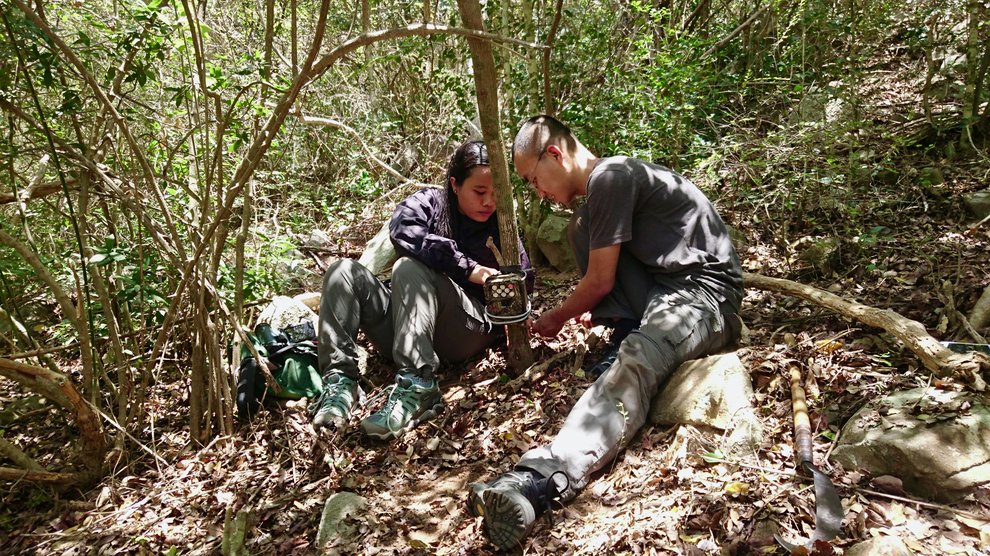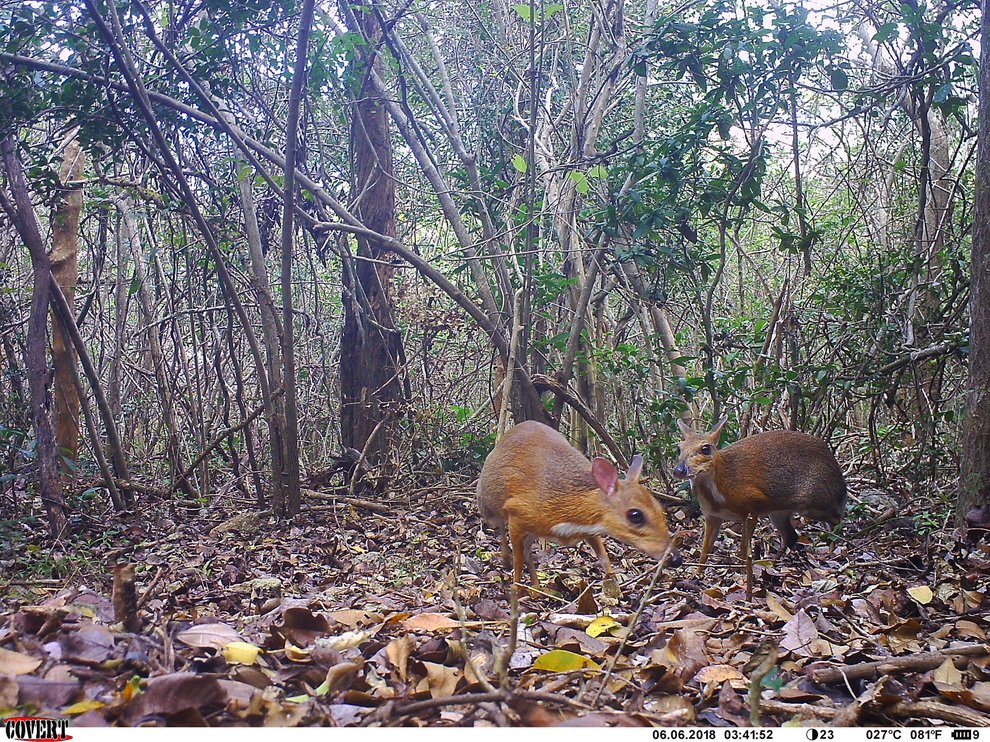Feast your eyes on the first-ever photos of a silver-backed chevrotain in the wild
The images confirm the species, which has been “lost” to science for 29 years, is alive and well in its native Vietnam.

A wild silver-backed chevrotain appeared! Image Credit: SIE/GWC/Leibniz-IZW/NCNP Copyright holder: Andrew Tilker
Of the many animals Andrew Tilker studies, there are plenty he’s never actually seen in person.
It can feel a bit like chasing after mythical beasts, admits the Global Wildlife Conservation biologist. But that’s par for the course, he says, when you’re searching for species considered “lost” to science.
That’s certainly been the case for the silver-backed chevrotain (Tragulus versicolor)—a fanged, cat-sized deer relative that looks like it lowered itself halfway into a bath of metallic paint before changing its mind. Though Western researchers have known about this skittish creature for more than a century, they’ve collected only five specimens, all corpses obtained from hunters in Vietnam.
The last of these appeared nearly three decades ago, in 1990. No Western biologist—Tilker included—has ever glimpsed a silver-backed chevrotain alive.
But now, with the help of local knowledge and a cluster of well-placed camera traps, Tilker and his team have snapped the first-ever photos and videos of the silver-backed chevrotain in the wild. Their findings, published today in the journal Nature Ecology & Evolution, go beyond the glamour shot: They confirm that, despite decades of illegal poaching and habitat destruction, this mysterious mini-mammal remains alive and well in its native Vietnam—for now.
“We should think that we’re still pretty damn lucky that this species is still around,” says Liana Zanette, a conservation biologist at Western University in Canada who wasn’t involved in the study. “We’ve been given another opportunity to try and preserve it, and that’s where the focus needs to be now.”
This scientific rediscovery is another notch in the belt of Global Wildlife Conservation, which, in 2017, launched a campaign to scour the world for 1,200 species lost to science. The silver-backed chevrotain is the first mammal checked off the organization’s 25 “most wanted” list, joining several other “found” plants and animals, including a golden salamander salamander in Guatemala, a gargantuan tortoise in Ecuador, a giant bee in Indonesia, and a flesh-hungry pitcher plant in Canada.

A silver-backed chevrotain shows off its metallic backside. Image Credit: SIE/GWC/Leibniz-IZW/NCNP Copyright holder: Andrew Tilker
Like many of its predecessors, the silver-backed chevrotain (sometimes called the Vietnam mouse-deer) is as enigmatic as it is elusive. It first came onto the scientific scene in 1907, after a biologist collected four dead specimens near Nha Trang, Vietnam. Like other chevrotains, they sported short, spindly legs that could help them scuttle through the forest, and odd, elongated fangs that males might use for fighting. But in contrast to the more common lesser chevrotain (Tragulus kanchil), a close relative also native to the region, the silver-backed species lacked a distinctive stripe on its throat and “looked as though someone had dunked two thirds of it in silver,” Tilker says.
There was only so much scientists could figure out from the bodies, which were filed away into collections in the hopes that more individuals would appear. But then the trail went cold.

Researchers set up a camera trap to capture images of the elusive silver-backed chevrotain near Nha Trang, Vietnam. Image Credit: SIE/GWC/Leibniz-IZW/NCNP
The next chevrotain didn’t appear until 83 years later, when a team of Vietnamese and Russian scientists nabbed another hunter-killed specimen in Gia Lai, a province more than a hundred miles away from the original site.
By the time the species blipped onto the radar of Tilker and his colleagues some two decades later, it was clear in that the silver-backed chevrotain might be in some trouble. Poaching and habitat destruction had already triggered the decline of several other animals in the region—and scientists began to worry that they’d lose the strange little creature before it had truly been found.
But “species shouldn’t be written off just because they haven’t been seen,” Tilker says. So he and his colleague An Nguyen decided to do some scientific sleuthing of their own. The best bet for pinpointing a chevrotin population, Nguyen says, would be to go back to the source: Nha Trang, where four of the five precious specimens had first been recovered—and, they later learned, where a photo of an oddly colored young chevrotain had supposedly been taken in 2004.
In 2017, a team led by Nguyen began interviewing residents around Nha Trang. While Western scientists have yet to glimpse a living silver-backed chevrotin, he says, the animals—known to the Vietnamese as cheo cheo—were nothing new to locals: About a quarter of the 35 people the researchers interviewed said they had recently spotted gray-looking chevrotains nearby.
That fall, the researchers planted three camera traps—which, when triggered by motion, snap images and record videos of their surroundings—near where the sightings had occurred. These devices, Zanette explains, give scientists a way to keep tabs on rare animals in remote regions without making the trek themselves.
When the team collected the traps the next spring, Nguyen wasn’t expecting to see much. But within the first 30 photos, a small, silver-speckled creature flashed onto his screen. Then there was another—and another. All three cameras had captured silver-backed chevrotains.
“I got very excited,” Nguyen says. “It was a joy to see.”

The silver-backed chevrotain is a baffling mishmash of traits: a round body, sharp fangs, spindly legs, even-toed hooves, and a splash of metallic fur. Image Credit: SIE/GWC/Leibniz-IZW/NCNP Copyright holder: Andrew Tilker
Eager for more, the team returned to the region, this time setting ten times as many traps as before. Within three months, they’d amassed evidence of another 208 sightings.
“This was a classic case of an animal that wasn’t that hard to find as long as somebody looked for it in the right place,” Tilker says.
One of the most exciting parts about this story is how critical local voices were to the scientists’ success, says Mairin Balisi, a paleontologist and evolutionary biologist at La Brea Tar Pits who wasn’t involved in the study. “[Conservation] can’t just be scientists working together. It has to be scientists and local community members working together.”
That human element, in combination with the cutting-edge technology of camera traps, makes this “a fantastic detective story,” Zanette says. “You need the pictures to prove a species exists. Now we can do all that.”

Study author An Nguyen gets a new tally mark on his wrist tattoo each time he discovers a mammal in the wild that he’s never detected before. The silver-backed chevrotain marks his fiftieth find. Image Credit: Courtesy of An Nguyen
The most important next step is to get a better sense of how many chevrotains are left, Tilker says, which is hard to do with just photos and videos. But, he notes, most of the team’s interviewees noted a recent and sharp decline in chevrotain numbers. Hunting and habitat destruction have stripped Vietnam and surrounding countries of many of their animals, where “empty forest syndrome” has spread like contagion, Tilker says.
As such, Tilker and his colleagues have also been careful not to disclose too much about the chevrotain’s whereabouts. Awareness, he explains, is a double-edged sword: Hunters have previously used published scientific data to home in on their marks.
Even though it’s been found in the forest, the silver-backed chevrotain isn’t yet out of the woods.
“We...have this remarkable opportunity in our hands to protect a species that has come back onto the radar,” Tilker says. “Second chances like this don’t come around that often.”
To learn more about how scientists are spying on the world’s creatures, stream “Animal Espionage” or tune in on November 27 at 9/8c on PBS.



